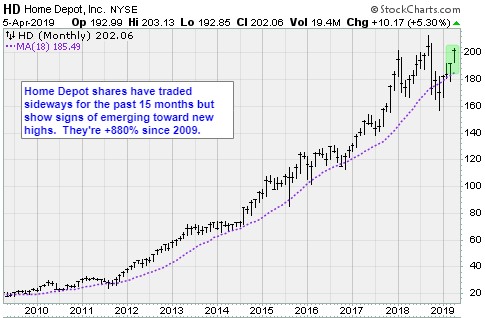Despite what you may have heard, Amazon.com is not killing retail. Shoppers actually like stores, and some are thriving like never before.
Home Depot (HD) is growing sales and net earnings the old-fashioned way. The company’s success secret is simple: It keeps making it easier for customers to buy the things they need.
And it just completed its best year ever.
This is a simple story of a smart company whose stock has plenty of room to run.
The Atlanta home improvement retailer is part of a trend many investors probably missed while waiting for the Amazon apocalypse …
Some stores are destinations. You can spot them a mile away. Their parking lots are full, or their mall locations pulsate with throngs of excited shoppers.
Costco Wholesale (COST), Nike (NKE), Lululemon (LULU), Apple (AAPL) and Sephora, the LVMT-owned makeup superstore, all fit this bill. But Home Depot, with its simple orange signage and aproned staff, is the granddaddy of them all.
Long ago, company managers figured out they could get suburban moms and dads to hang around the garden center and tool cribs with in-store demonstrations and plenty of knowledgeable, friendly staff.
A trip to their big-box stores became a Saturday morning event in neighborhoods all over the country. Home Depot became the obvious destination for grabbing a tool, or maybe even a new grill.
The final touch, and it was masterful, was ensuring the digital side of the business was secure. This meant an aggressive internet push with more shipping options for professionals, and lots of infrastructure work behind the scenes to make sure inventories were in check.
It turns out, when customers leave stores because the item is out of stock, they don’t come back.
During the fourth-quarter conference call in February, CEO Craig Menear told analysts that the company’s digital project onboarded 100,000 contractors during fiscal 2018. And the plan is to sign up 1 million members in 2019.
Professionals will be able to order products online or with a mobile app and have those purchases instantly show up in their pro accounts. They will also be able to arrange delivery to job sites and, in some cases, pick up items at automated lockers — bypassing checkout lines altogether.
The Wall Street Journal reported last summer that Home Depot was spending $1.2 billion to add 170 distribution sites, so it can reach 90% of the U.S. population in one day or less.
Small contractors are key. Despite Home Depot’s success with average shoppers, the professional market remains extremely fragmented. Smaller regional hardware chains still command large parts of the marketplace. Consolidating that business, with its superior economies of scale, represents a huge opportunity for the home improvement giant.
So far, connecting the shopping experience is paying dividends. Online sales grew 22.7% in the fourth quarter, and 24.1% in 2018. Digital now represents 7.9% of sales.
The other part of the story is infrastructure. Managers discovered the company was leaving a lot of business on the table with out-of-stock inventory.
The One Home Depot plan, revealed in 2016, set an aggressive five-year rollout to make its digital and physical presences seamless. Customers can start an order online and pick up at the store, or vice versa. They can also check inventory from their smartphones, in real time.
The goal is to remove friction, and sell more products.
To help, the company is ramping up its mobile game. In addition to checking stock, customers will be able to see store-specific maps on their smartphones. Finding 3M painter’s tape or the perfect light for the new patio will be just a tap or a swipe away.
Long ago, Home Depot managers discovered they could get people into their clean, well-lit suburban stores with DIY demonstrations. Now they’re working to ensure customers have multiple ways to get the products they want, when they want them.
The company had $108 billion in sales in fiscal 2019, up 7.2% year-over-year. Profits surged 28.9% to $11.1 billion, as the digital strategy begins to pay dividends.
Shares trade at 18.3x forward earnings, and 2x sales. These are reasonable multiples for a company growing so fast for its size, and with considerable competitive advantages.
The stock should be bought into any significant weakness. Given current growth rates, shares could trade to $260 in three years.
Best wishes,
Jon D. Markman
P.S. Like I told my Power Elite members on Friday, the best stocks make returns, not waves. The Amazons and Googles of the world get all the attention for their big innovations. But other companies are using big innovations like data science and machine learning to quietly disrupt their respective industries. To learn more about how we invest in stocks that don’t need a single headline to boost their prices by double-digits every year — and which stocks you can buy, right now — click here.





